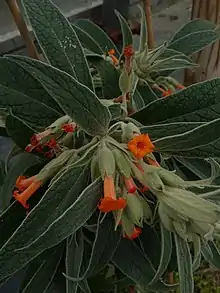Buddleja speciosissima
Buddleja speciosissima is a rare species restricted to Mount Itatiaia in Brazil, where it grows in rocky grassland at elevations of 2,000–2,500 m. It was first described and named by Taubert in 1893.[1][2]
| Buddleja speciosissima | |
|---|---|
 | |
| Scientific classification | |
| Kingdom: | Plantae |
| Clade: | Tracheophytes |
| Clade: | Angiosperms |
| Clade: | Eudicots |
| Clade: | Asterids |
| Order: | Lamiales |
| Family: | Scrophulariaceae |
| Genus: | Buddleja |
| Species: | B. speciosissima |
| Binomial name | |
| Buddleja speciosissima | |
| Synonyms | |
| |
Description
Buddleja speciosissima is a shrub 1–3 m high with light-brown fissured bark. It bears hermaphroditic flowers, unlike most South American members of the genus which are cryptically dioecious.[2] The young branches are thick, subquadrangular, and covered with a dense pale yellow indumentum, bearing subcoriaceous elliptic to lanceolate leaves with 1–3.5 cm petioles, and measuring 10–18 cm long by 2–4 cm wide, glabrescent above but tomentose below. The reddish-orange leafy inflorescences are 10–20 cm long, comprising 1–2 orders of branches bearing paired three flowered cymes, the corollas 25–30 mm long by 4 mm wide, pollination being by hummingbirds. Ploidy: 2n = 38.[2]
Cultivation
The shrub is rare in cultivation.
References
- Taubert, P. W. H. (1913). Bot. Jahrb Syst. 17: 513. 1893
- Norman, E. M. (2000). Buddlejaceae. Flora Neotropica 81. New York Botanical Garden, USA